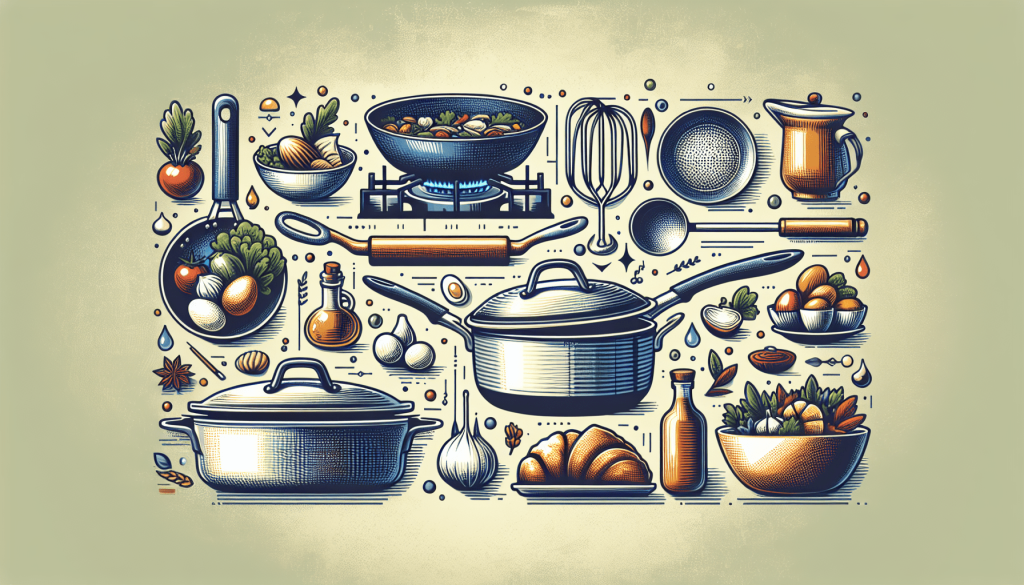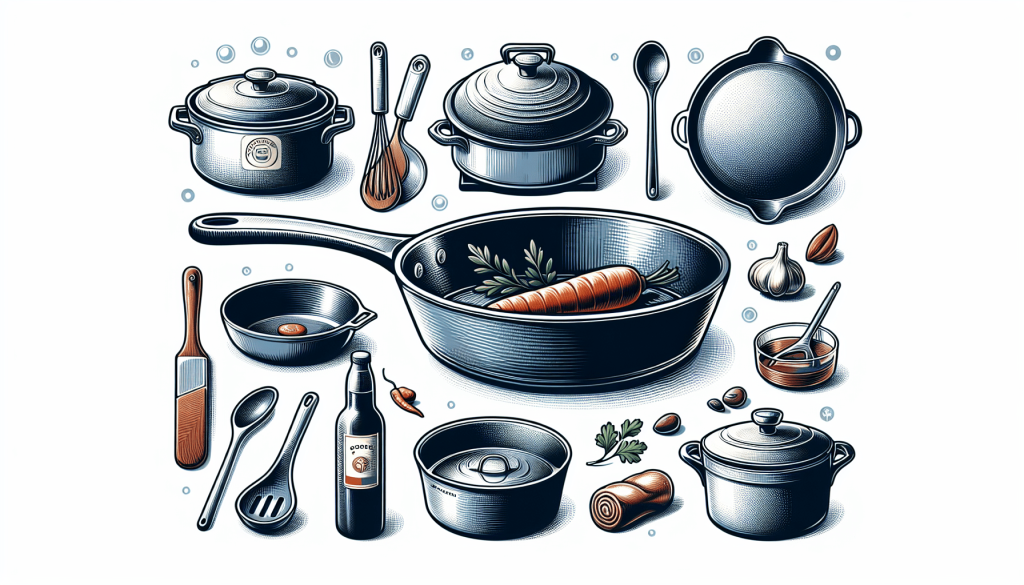You’re about to embark on a culinary adventure, exploring the vast world of cooking techniques. But with so many options and recipes at your fingertips, how do you choose the right cookware for each method? From sautéing and braising to grilling and baking, this article will guide you through the process of selecting the perfect pots and pans for your kitchen. So grab your apron and get ready to master the art of cooking with precision and flair!
Understanding Different Cooking Techniques
When it comes to cooking, there are various techniques that you can employ to create delicious and mouth-watering dishes. From frying to boiling and from baking to sautéing, each cooking method has its unique characteristics and requirements. By understanding these different techniques, you can enhance your culinary skills and create meals that will impress even the most discerning taste buds. So, let’s dive into the world of cooking techniques and explore the possibilities!
Frying
Frying is a popular cooking technique that involves cooking food in oil or fat at a high temperature. Whether you’re making crispy french fries or golden-brown chicken nuggets, frying can give your dishes a delectable texture and flavor. To achieve the perfect fried dish, it’s essential to choose the right cookware. The best cookware for frying includes a cast iron skillet, a stainless steel skillet, a carbon steel skillet, or a non-stick fry pan. These options provide excellent heat conductivity, durability, and heat distribution to ensure your food is cooked evenly and to perfection.
Boiling
Boiling is a simple yet versatile cooking technique that is commonly used for preparing soups, pasta, vegetables, and more. It involves submerging food in a liquid and heating it until it reaches its boiling point. When it comes to choosing cookware for boiling, you want to opt for pots that can withstand high temperatures and distribute heat evenly. A stockpot, Dutch oven, or saucepan are ideal choices for boiling. These cookware options are durable, provide efficient heat distribution, and come in various sizes to accommodate your cooking needs.
Baking
Baking is a beloved cooking technique that allows you to create a wide range of sweet and savory treats. Whether you’re whipping up a batch of cookies or baking a mouth-watering lasagna, the right cookware can make all the difference. For baking, you’ll need cookware such as a baking sheet, cake pan, muffin tin, pie dish, loaf pan, or roasting pan. These options are designed to evenly distribute heat and allow for proper airflow, resulting in perfectly baked goods with a golden and crispy exterior.
Steaming
Steaming is a healthy and gentle cooking technique that helps to retain the nutrients, color, and texture of food. From vegetables to fish and dumplings, steaming can be used for a variety of dishes. To effectively steam your food, you’ll need the right cookware. Consider investing in a steamer insert, bamboo steamer, or stainless steel steamer pot. These options provide a sturdy and reliable base for steaming your ingredients while allowing the steam to circulate evenly for thorough cooking.
Sautéing
Sautéing is a cooking technique that involves quickly frying food in a shallow pan over high heat. It’s a fantastic way to achieve that perfect sear on meats or cook vegetables to perfection. When it comes to sautéing, you’ll want to choose cookware that can withstand high heat and provide efficient heat distribution. A sauté pan, stainless steel skillet, or copper sauté pan are excellent options. These cookware choices offer durability, even heat distribution, and a spacious cooking surface to accommodate your ingredients.
Grilling
Grilling is a favorite cooking technique, especially during the warmer months when we love to gather outdoors and enjoy the smoky flavors of grilled meat, vegetables, and seafood. Whether you have a backyard grill or are using a stovetop grill pan, having the right cookware is essential. A grill pan, outdoor grill, or grill basket are excellent choices for grilling. These options allow for even heat distribution, provide those distinct grill marks, and allow excess fat to be drained away to ensure delicious and healthy grilled dishes.
Roasting
Roasting is a cooking technique that involves cooking food in an oven at a high temperature. It’s a versatile method that can be used for meats, vegetables, and even fruits. To achieve that perfect roast, you’ll want to invest in the right cookware. A roasting pan with a sturdy construction and a roasting rack to elevate the food off the pan’s surface is essential. These cookware options allow for even heat distribution, promote proper browning, and help to collect drippings for flavorful gravies and sauces.
Simmering
Simmering is a gentle and slow-cooking technique that involves cooking food in a liquid at a low temperature. It’s perfect for creating tender and flavorful stews, soups, and braised dishes. For simmering, you’ll want cookware that can retain heat well and provide even heat distribution. A heavy-bottomed saucepan or Dutch oven are excellent choices for simmering. These options allow for gentle and consistent heat, which is crucial when cooking dishes that require long cooking times.
Stewing
Stewing is another slow-cooking technique that involves cooking food in a liquid for an extended period. It’s similar to simmering but typically uses smaller pieces of meat and a higher ratio of liquid. When it comes to stewing, you’ll want cookware that can hold a large quantity of liquid and distribute heat evenly. A deep pot or Dutch oven with a tight-fitting lid is ideal for stewing. Cookware with excellent heat retention and sturdy construction ensures that your stew will cook evenly and develop rich flavors.
Broiling
Broiling is a cooking technique that involves exposing food to direct heat from above. It’s perfect for achieving that crispy and caramelized crust on dishes like steak, fish fillets, or even desserts. To broil your food, you’ll want cookware that can withstand high temperatures without warping or becoming damaged. A broiler pan or a broiler-safe baking dish is essential for this technique. These cookware options are designed to withstand the intense heat of the broiler while allowing excess fat to drain away for flavorful and healthier results.

Considerations When Choosing Cookware
Now that we’ve explored the various cookware options for different cooking techniques, let’s take a look at some important considerations to keep in mind when choosing your kitchen arsenal.
Heat Conductivity
Opt for cookware that provides excellent heat conductivity. This ensures that heat is evenly distributed throughout the cooking surface, preventing hot spots and allowing for consistent cooking.
Durability
Choose cookware that is built to withstand the test of time. Look for materials like stainless steel, cast iron, or copper, which offer durability and longevity.
Heat Distribution
Cookware with even heat distribution ensures that your food cooks uniformly and prevents any parts from being over or undercooked. Look for cookware with multiple layers or materials engineered to provide efficient heat distribution.
Non-Stick Coating
Consider whether you prefer cookware with a non-stick coating. This feature can make cooking and cleaning much easier. However, keep in mind that non-stick coatings may require more delicate handling and have a shorter lifespan than other types of cookware.
Oven-Safe
If you frequently use your oven for cooking or finishing dishes, choose cookware that is oven-safe. This allows you to seamlessly transition from stovetop to oven without having to transfer your ingredients to separate oven-safe dishes.
Size and Capacity
Consider the size and capacity of the cookware you need. Choose options that accommodate your typical batch sizes and cater to your cooking needs. Having the right size cookware ensures efficient cooking and prevents overcrowding of ingredients.
Maintenance and Care
Think about how much time and effort you’re willing to dedicate to cookware maintenance and care. Some materials, like cast iron, require seasoning and special cleaning methods, while others may be dishwasher safe for easy cleaning.
Budget-Friendly
Consider your budget when selecting cookware. While high-end options may offer superior performance and durability, there are budget-friendly alternatives available that still provide satisfactory results.
Cooking Surface Compatibility
Take into account the type of stovetop or cooking surface you have. Certain materials, such as copper, may not be compatible with induction cooktops. Ensure that your cookware is suitable for your specific cooking setup.
Weight and Ease of Use
Consider the weight and ease of use of the cookware. Cookware that is too heavy may be difficult to maneuver and lift, especially when filled with ingredients. Opt for cookware that strikes a balance between sturdiness and ease of handling.
Now armed with the knowledge of different cooking techniques and considerations for choosing cookware, you can confidently embark on your culinary adventures. Remember to select the right cookware for each cooking technique, and soon you’ll be creating delicious meals that will impress both your family and guests. Happy cooking!

